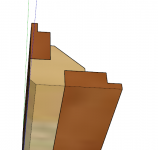Richard/RMW
Member
- Joined
- Jul 11, 2010
- Messages
- 2,947
I'm trying to come up with a design for a large box, around 16" tall, somewhere around 14-16" wide and perhaps 12" deep. I want use up a large supply of 3/4 by 2" cherry strips I have and make the sides from frames then rabbet the inside edges and infill with ~1\4" panels overlaid with leather (another on hand material). Picture a common frame and panel cabinet door. Not sure yet what the top would consist of.
I don't want this to become a major project so I'm aiming to whack out the basic box in a weekend at most. Given the narrowness of the stock at 2" I don't thinkbox finger [edit] joints or similar would look good. I'm also thinking I can use the Shaper Origin to add some details, perhaps brass pins or???
I'm also wondering if the best approach is the make all 4 of the side panels and then join them together into the box. Perhaps using a rabbeted corner post, with a 45 degree detail? I've also got plenty of 8/4 & even 12/4 stock to play with, in contrasting materials like ash, sycamore, maple.
Looking for any suggestions anyone may have. Thanks in advance.
RMW
I don't want this to become a major project so I'm aiming to whack out the basic box in a weekend at most. Given the narrowness of the stock at 2" I don't think
I'm also wondering if the best approach is the make all 4 of the side panels and then join them together into the box. Perhaps using a rabbeted corner post, with a 45 degree detail? I've also got plenty of 8/4 & even 12/4 stock to play with, in contrasting materials like ash, sycamore, maple.
Looking for any suggestions anyone may have. Thanks in advance.
RMW



